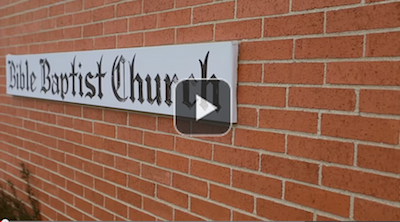MARCH 12 / MARCH 19, 2017
CHRIST’S FIRST DISCIPLES
INTRODUCTION:
1. We have been considering the three testimonies of John the Baptist. These testimonies occurred on three consecutive days.
a) John, having first denied that he was himself the Messiah, testified that Christ was presently among them. “There standeth one among you…” (Verse 26) In saying, “I am the voice,” i.e. he who prepares the way for Messiah, (Vs 23; Isa. 40:3) he was, in fact, confirming, He is here.
b) “The next day” John testified, “There He is” (Verse 29) He pointed to the actual physical Person of the Messiah, and said, “Behold, the Lamb of God.”
c) “Again the next day,” John would testify in the most practical sense, essentially saying, “Follow Him” To two of his own disciples, John said, “Behold the Lamb of God!” Those two disciples clearly understood their master to be saying, “Follow Him!”
2. John’s third testimony assumed a still more precise nature. (Verses 35-37)
a) It seems that this third and most practical testimony was missed by the official delegation. They had apparently returned to Jerusalem the day before without even asking John who the Messiah was of whom he spoke.
b) John remained with two of his disciples at his side, who, when they heard his exhortation, took heed, and “followed Jesus.”
3. Here we have an account of the calling of Christ’s first disciples. These are called in two groups, and picture all who become His followers.
I. THE FIRST GROUP WAS MADE UP OF FOUR OF JOHN’S DISCIPLES, WHO, WITH HIS FULL BLESSING, BECAME FOLLOWERS OF CHRIST. (VERSES 35-42) NOTE: We assert that there were four men in this first group, although only three are mentioned, Andrew, his unnamed companion, and Peter, Andrew’s brother. Collective gospel history would suggest that when Andrew went to find his brother, his companion, whom we know was John (the author of this Gospel), also went and found his brother James, who was also part of this first group.
A. THE FIRST TWO DISCIPLES RESPONDED TO JOHN’S PUBLIC DECLARATION. (VERSES 35-37)
1. Both were disciples of John. (Verse 37)
a) These unnamed men were two disciples out of a much greater number who were follower of John. They understood John’s declaration, “Behold the Lamb of God” (Verse 36) to mean “Follow Him” and were moved to do so.
(1) Here we see evidence of the Holy Spirit’s work, inclining them to leave their present master to follow Him whom they had never seen before. When one in faith obeys the Gospel command, it is always the Holy Spirit’s work.
(2) We also have an example of true loyalty. John’s one purpose was to bear witness of Christ and see His increase. Without the least degree of jealousy, he pointed his disciples to Christ.
b) One of the two first responders is soon to be named. (Verse 40) His name is Andrew. The other remains unnamed, but there can be no doubt that it is John, the writer of this Gospel.
(1) In modesty, he does not name himself, though the precise, intimate details here given demand an eyewitness.
(2) Neither does he name his brother, James, who as before noted doubtlessly was also among these mentioned.
2. Notice, as they began to follow Jesus, perhaps timidly, they were acknowledged by Him, and extended a welcoming invitation. (Verses 38, 39)
a) Jesus inquired of them, knowing full well what they were seeking. (Verse 36)
b) Their answer expressed in a modest way that they desired to speak with Him in private. “Rabbi, (Master, Teacher) where dwellest Thou? (Verse 38)
c) Jesus said to them, “Come and see.” The meaning is come at once.
d) They spent the rest of the day enjoying a glorious personal visit with the Lord Jesus. From about the tenth hour (4 o’clock in the afternoon) onward they were with Him.
e) We do not know where He dwelt, but needless to say, their interests went far beyond the seeing where Jesus lived. (Verse 41)
3. So, the first two disciples were a result of John’s public declaration, which was essentially a Gospel command, Follow Him!
B. THE THIRD DISCIPLES CAME TO JESUS BY PERSONAL TESTIMONY AND WITNESS. (VRS. 40-42)
1. At this point in the narrative, we officially learn from the author who his companion was, who along with himself, first followed Jesus. (Verse 40)
2. It was necessary to name Andrew in order to point out his relationship to this third disciple, who was Simon Peter, Andrew’s brother. (Verse 41)
a) Notice, John refers to him by his surname, “Peter,” which obviously at this point in the history, had not yet been given.
b) This shows that at the time of John’s writing, his readers were already familiar with the Gospel history.
3. Evidently both John and Andrew set out to find their own brothers, so anxious were they to introduce them to Jesus.
a) Even though we are not specifically told that John went to find his brother, we do know that James was also among the young Galilean disciples of John the Baptist. Since James was among the earliest of Christ’s disciples, it is only reasonable to assume that John who shared the enthusiasm of his companion, and had immediately gone to find him.
b) No doubt John and Andrew were in complete agreement about the fact that they had found the Messiah.
4. What a wonderful and blessed encounter Peter had with Jesus! It was a most remarkable interview. (Verse 42)
a) Andrew brought Peter to Jesus later that same day.
b) Jesus, at first sight of Peter, saw him through and through. “Jesus beheld him.”
c) Though Jesus had never met Simon in the flesh, no introduction was necessary, for He had perfect knowledge of him, even from birth. Jesus said, “Thou art Simon the son of Jona.” (John 1:42) (See Jer. 1:5; Gal. 1:15)
d) Jesus then gave him a surname which revealed that, in addition to perfect acquaintance with Simon in the past, He also had perfect knowledge of his future. “Thou shall be called Cephas.”
(1) Jesus gave Simon a new name which revealed elements of the future person he would become.
(2) Jesus gave him the name “Cephas,” or “Peter,” which means “a stone.”
(3) A change of names in Scripture signifies a change of character.
(a) “Abram” (exalted father) became “Abraham” (father of many nations). (Gen. 17:5)
(b) “Jacob” (supplanter) became “Israel” (a prince with God). (Gen. 32:28)
e) In giving Peter this new name, Jesus took possession of him, and consecrated him for the work that He would appoint to him.
f) All who come to Jesus in faith are made new creatures in Christ. (II Cor. 5:17)
II. THE SECOND GROUP OF DISCIPLES WAS GATHERED AS JESUS WAS GOING FROM JUDEA TO GALILEE. (VERSES 43-51)
A. JESUS LEFT JUDEA TO GO BACK HOME TO GALILEE. (VERSES 43a)
1. His present mission in Judea was now complete.
a) He had come to Judea for His baptism.
b) He had received John’s witness.
2. He would now return home for a while before returning for the Jew’s Passover, at which time he would inaugurate His Messianic Ministry at Jerusalem. (Ch. 2:13ff)
3. The journey home was not lost or idle time, but rather quite purposeful, as two more disciples were called.
B. THE CALLING OF THESE DISCIPLES PROVIDES AN EXAMPLE OF THE PRACTICAL PROPAGATION OF FAITH. (VERSES 43b-46)
1. We saw in the calling of the first group how one lighted torch ignites another.
a) John and Andrew, having been lit by John (Verse 37), each sought his brother, Andrew found Peter, and John found James. (Verse 41)
b) Now Philip is called, who was a friend of Andrew and Peter. All these had been disciples of John the Baptist.
2. Philip, who was called directly (Verse 43), was doubtless the result of influence.
a) Andrew and Peter, who were of the same city, had almost certainly already talked to him about Jesus. (Vs. 44)
b) While in their company, Jesus bids him to come. “Follow Me.”
3. Philip seeks out his friend, Nathanael. (Verses 45, 46)
a) His testimony is bright and enthusiastic, and from the heart. (Verse 45)
b) It is doctrinally flawed, but not intentionally. He was simply unformed.
c) To Nathanael’s question, which seemed to indicate doubt, Philip simply answered, “Come and see.” (Vs. 46)
(1) By “anything good” Nathanael means “anything as good, as glorious as Messiah.”
(2) Philip, rather than try and answer, wisely said, come and see for yourself.
C. TO EVERY GENUINE AND HONEST SEEKER JESUS WILL PROVE HIMSELF. (VERSES 47-51)
1. Nathanael was just such a devout soul who had only to see Jesus in order to believe on Him.
2. Jesus, seeing into his very soul, spoke aloud of his good character, which was a reflection of what every Israelite ought to be. (Verse 47)
3. Nathanael was puzzled, and desired to know on what basis Jesus had made this moral judgment of him. (Vs. 48a)
4. Jesus then revealed to him his higher knowledge of him, a vision that was not merely human, but divine. (Verse 48b)
5. Jesus, being God, and all-seeing, had seen Nathanael under the fig tree, where apparently he was engaged in private devotion and prayer. Most likely he was searching, and crying out to God.
6. He then knew that Jesus’ vision had penetrated him there, and this brought forth a marvelous confession. (Vs. 49)
a) He confessed Jesus as “the Son of God.” How else could He have such knowledge?
b) He declared Him to be “the King of Israel.” He saw the relationship between Him and the chosen people, indeed He was their Messiah, as Philip had said.
7. Jesus confirmed Nathanael’s faith, and promised more to come, not only for him, but for all the other disciples. (Verses 50, 51)
a) The question that Jesus here asked has the force of a confirmation. (Verse 50) “You believe, and therefore you shall see.”
b) Jesus said, “Verily, verily.” (“Amen, amen.”) This is the first of twenty-five such expressions in John’s Gospel. As an introduction to a declaration, it belongs exclusively to Jesus.
8. Jesus, in Verse 51, alludes to “Jacob’s ladder,” which Jacob saw in his dream, with angels ascending and descending upon it. (Gen. 28:12)
a) Heaven is now permanently opened in the Person of Jesus Christ and His work.
b) Jesus Christ is the one Mediator between heaven and earth.
c) It is upon Christ that our prayers ascend up to God, and upon whom God’s blessings descend to us.
d) He here refers to Himself as “The Son of Man.” He has opened heaven to all mankind, and is the one Mediator between God and man.



Speak Your Mind